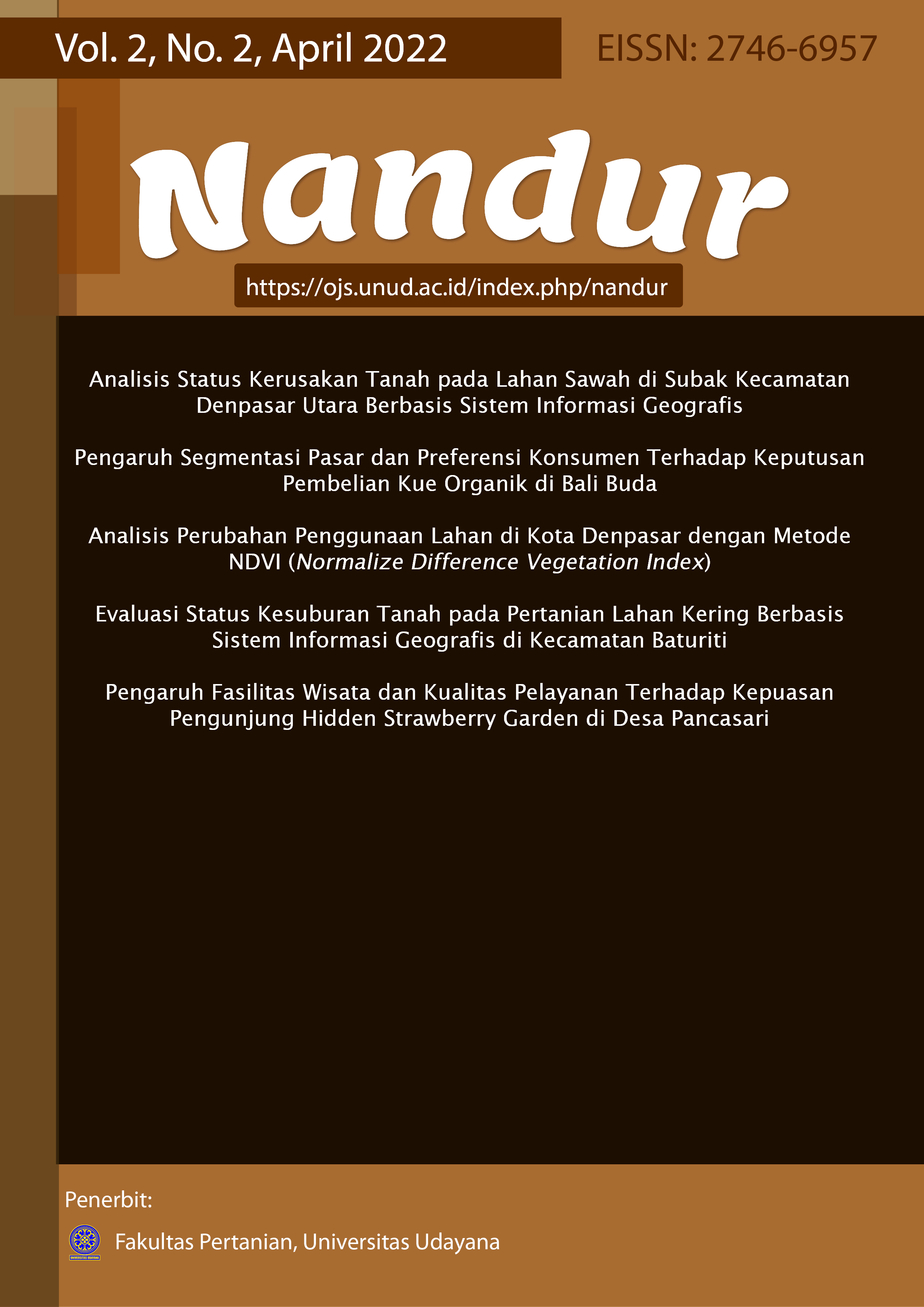Analisis Status Kerusakan Tanah pada Lahan Sawah di Subak Kecamatan Denpasar Utara Berbasis Sistem Informasi Geografis
Abstract
This study aims to determine the status of soil damage, limiting factors, create a map of the status of soil damage, and provide recommendations for repairing soil damage. This research was carried out in Subak, North Denpasar District, from December 2020 to February 2021. The research method was carried out using a survey method, namely observation and soil sampling followed by laboratory analysis. Parameters analyzed were solum thickness, surface kerocks, fraction composition, total porosity, bulk density, electrical conductivity, pH, permeability, and the number of microbes. The results showed that the status of soil damage at the study site was classified as undamaged (N) and lightly damaged (R.I). The undamaged status includes Subak Dalem, Subak Lungatad, Subak Ubung and slightly damaged status includes Subak Kedua, Subak Pakel II, Subak Petangan, Subak Pakel I, Subak Sembung. The limiting factors of the research area are permeability and fraction composition. Recommendations for improvement from the results of the research are the application of Organic-Based Controlled Aerobic Rice Intensification (IPAT-BO) technology, such as the provision of organic matter in the form of rice straw residues and good soil management by plowing the land using cattle or tractor power.
References
Gunawan, B. (2011). Pemanfaatan Sistem Informasi Geografis untuk Analisa Potensi Sumber Daya Lahan Pertanian di Kabupaten Kudus. Jurnal Sains dan Teknologi, Vol. 4(2): 122-132.
Hardjowigeno, S. (2003). Klasifikasi Tanah dan Pedogenesis. Akademika Pressindo, Jakarta. 354 hal.
Kementerian Negara Lingkungan Hidup Republik Indonesia. (2009). Pedoman Teknis Penyusunan Peta Status Kerusakan Tanah untuk Produksi Biomassa. Jakarta
Trigunasih, N. M., Lanya, I., Suwastika, A. A. N. G. (2020). Analisis Spasial Daya Dukung Lahan dan Lahan Pertanian Pangan Berkelanjutan (LP2B) di Sawah Subak Kota Denpasar (Laporan Akhir Penelitian Unggulan Udayana). Unpublished.
Peraturan Menteri Negara Lingkungan Hidup Nomor 07 Tahun 2006 tentang Tata Cara Pengukuran Kerusakan Tanah Baku untuk Produksi Biomassa.
Peraturan Pemerintah Nomor 150 Tahun 2000 tentang Pengendalian Kerusakan Tanah Untuk Produksi Biomassa.
Suripin. (2001). Pelestarian sumberdaya tanah dan air. Yogyakarta (ID): Andi.
Tolaka, W., Wardah., & Rahmawati. (2013). Sifat Fisik Tanah Pada Hutan Primer, Agroforestri dan Kebun Kakao di Subdas Wera Saluopa, Desa Leboni, Kecamatan Pamona, Peselemba Kabupaten Poso. Jurusan Kehutanan, Fakultas Kehutanan, Universitas Tadulako. WARTA RIMBA Vol. 1(1): 1-8.
Tufaila, M., & S, Alam. (2014). Karakteristik tanah dan evaluasi lahan untuk pengembangan tanaman padi sawah di Kecamatan Oheo Kabupaten Konawe Utara. Jurnal. Vol. 24: 0854-0128.
Vebriawandaru, B. P. (2020). Analisis Status Kerusakan Tanah Untuk Biomassa di Desa Beji Kecamatan Ngawen Kabupaten Gunungkidul. Disertasi. Yogyakarta: Universitas Pembangunan Nasional" Veteran" Yogyakarta.



